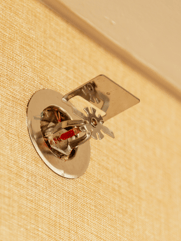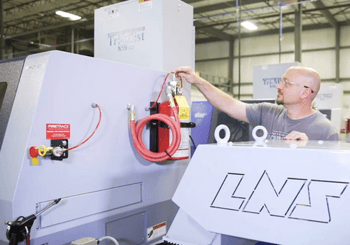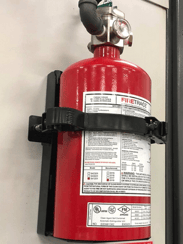Is a fire suppression system the same as a sprinkler system?
The short answer is no; they are not the same. Although they may share the same objective—suppressing and extinguishing a fire—their methods of doing so are very different. In this blog, we'll talk about the difference between a fire suppression system vs a sprinkler system so you can make an informed decision on which one would be suitable for your application.
What is a Fire Suppression System?
A fire suppression system is activated by heat, smoke, or a combination of both. It's used to extinguish and control fires by using gaseous, chemical, or foam fire suppression agents to suppress the fire, rather than water. At Firetrace, we specifically use CO2 and clean agents like FM-200TM and FK-5-1-12.
Areas such as server rooms, data centers, elevator shafts, warehouses with machinery, manufacturing facilities, archival rooms, and other similar places all benefit from fire suppression systems rather than sprinkler systems.
Fire suppression systems are also necessary for facilities that handle highly-combustible substances such as oil and gas since water is not adequate when these substances combust.
What Are the Different Types of Fire Suppression Systems?
Several types of fire suppression systems use chemical, gaseous, and foam fire suppression agents to suppress fires. Each of these types have specific applications. These agents include:
- Carbon Dioxide (CO2): This gaseous agent works efficiently and quickly to suppress a fire. However, it can be dangerous to human health. It's best used for unoccupied facilities.
- Dry Chemical Suppression: This type of system quickly extinguishes fires caused by combustible or flammable liquids. This agent is great for flammable liquid storage areas, furnace rooms, or mechanical rooms.
- Wet Chemical Suppression: This system utilizes a liquid agent and prevents re-ignition. This agent works well for Class K (kitchen) fires.
- Clean Agent Fire Suppression System: This type of system uses agents that leaves no residue, making it ideal for sensitive applications like museums, archives, libraries, computer or server rooms, etc. This system can use two types of clean agents: FM-200™ or FK-5-1-12.
Are you interested in fire suppression systems? Visit our Engineered Fire Suppression Systems page to learn about total flood applications.
What is a Fire Sprinkler System?
A fire sprinkler system controls and extinguishes fires through sprinklers that release water when the system is activated by heat, smoke, or both. Water sprinklers are safe to use on Class A, B, and C fires.
Fire sprinkler systems can be less expensive than fire suppression systems since they use water rather than other suppression agents. However, it is essential to consider where the system will be used. Water from a sprinkler system can damage certain types of property—leaving just as much damage as a fire might. A fire sprinkler system can also be ineffective against certain fires, like grease fires. For these reasons, it's important to consider the applications before installing a fire sprinkler system.
What Are the Four Types of Sprinkler Systems?
There are several types of sprinkler systems, depending on the application they're used for. These include:
- Deluge Sprinklers: In this system, the sprinkler heads are always open. The pipes only fill with water when the system is activated. This system is suitable for hazardous material storage or other areas with high hazards, like aircraft hangars.
- Dry Pipe Sprinklers: The sprinkler heads are closed in this system and the pipes are dry. The sprinkler heads open, and pipes will fill with water when the system is activated. Since the pipes are dry, this system works great for unheated buildings, like warehouses, where cold temperatures may cause full pipes to burst.
- Wet Pipe Sprinklers: In this system, pipes are constantly full with water, ready to release whenever the system is triggered. These systems are used in high-traffic, high-occupancy buildings like office buildings, high-rises, and hotels.
- Pre-Action Sprinklers: These systems are activated by a supplemental fire detection system. These systems are used to mitigate damage to sensitive areas caused by accidental activation, such as in museums, libraries, or archive rooms.
Fire Suppression System vs Sprinkler System
A fire suppression system and a fire sprinkler system have similar goals; when both of these systems detect heat or smoke, they activate and release their agents or water to suppress a fire. Fire sprinkler systems use water to extinguish and control flames and minimize the spread of fire until help arrives. Fire suppression systems use chemicals, gasses, or clean agents to suppress a fire.
Fire sprinkler systems are most often used in everyday applications to reduce property damage that fires can cause. Facilities use fire sprinklers for standard needs and water would most likely put out a fire.
In specific cases, a fire suppression system is the only option that can be used to safely and effectively extinguish a fire. Fire suppression systems are often used in areas where water could not put out a fire or when water would cause additional damage to property that the suppression system is intended to protect, such as in a data center or museums archive.

The work you're doing is essential. It's critical to have the correct system in place for any fire outbreak that happens in your building.
A Firetrace fire suppression system can help protect your business from costly repairs, downtime, and the potential loss of life.


